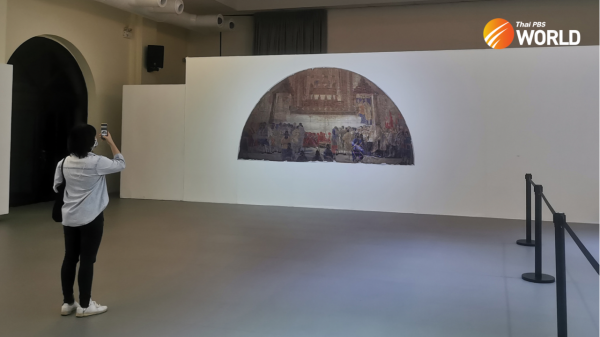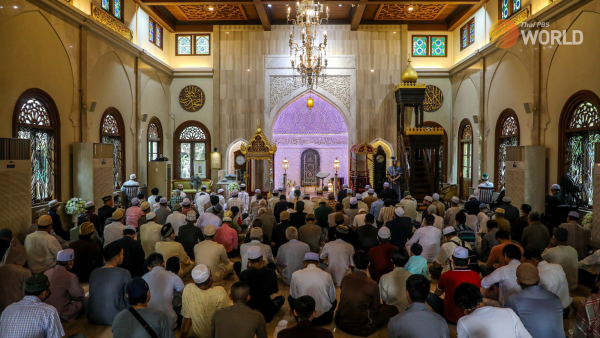Every picture tells a story
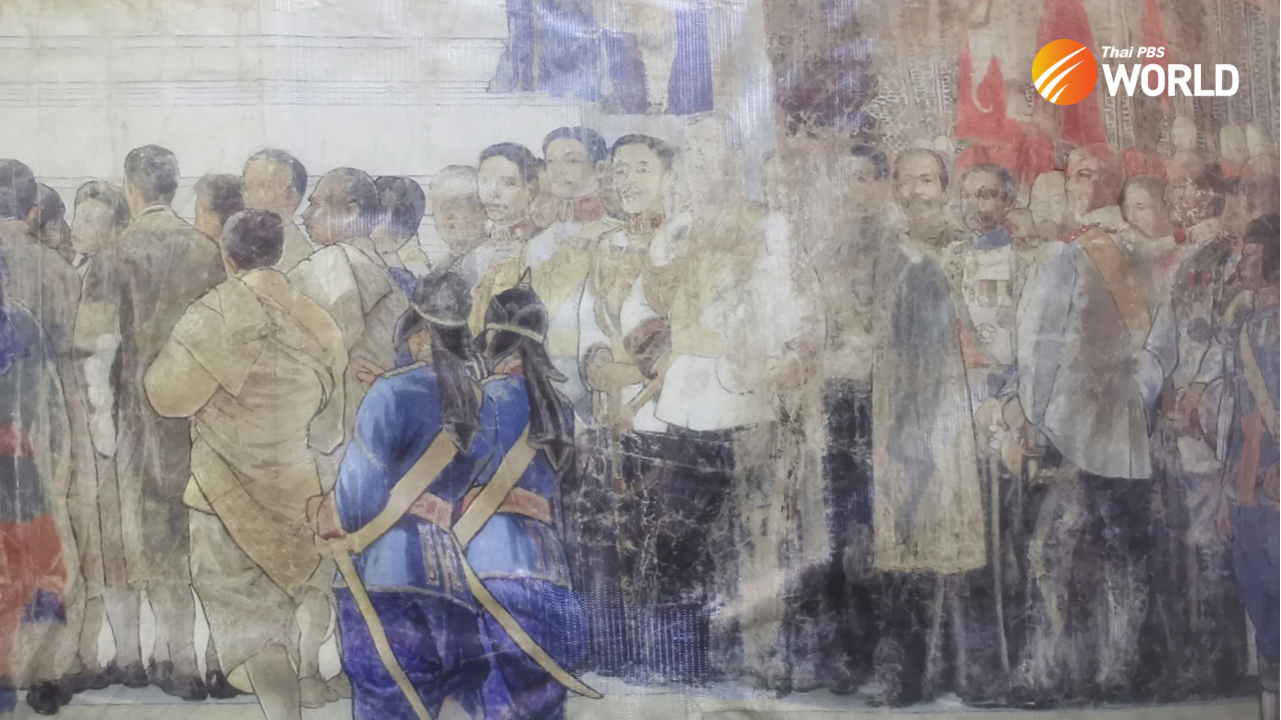
After three years of preservation, the long-lost sketch by Italian Galileo Chini, a prototype of the fresco on the ceiling of Ananta Samakhom Throne Hall, is up for a sneak preview. The sketch, which is a draft copy, has an amazing story of its own, and its repair process has taken Thailand’s art restoration to the next level by using science to save art.
“Many people asked why this preservation process took such a long time. The project has been going on for three years now, and it’s not quite finished. It takes time to learn something new,” says Saneh Mahaphol, a conservation scientist,” during the “Preserving Galileo Chini’sSketch: A New Challenge for Conservationists” seminar streamed on Facebook Live.
This is the first time the Fine Arts Department has introduced conservation science to historic art conservation on a full scale. Making the work even more challenging for the restorers was the size: Chini worked on a 9 by 5-meter canvas.
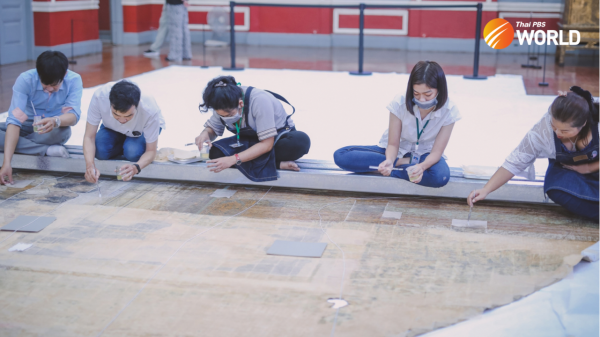
Siam’s very own Italian job
Chini was born in Florence in 1873. Like Michelangelo Buonarroti, Leonardo Da Vinci, and other Florentine artists before him, Chinimade a living as an artist. He signed a contract with the Royal Court of Siam on October 17, 1911 (a few days before King Chulalongkorn passed away) for the painting in the Ananta SamakhomThrone Hall, and began his career just as Prince Vajiravudh was acceding to the throne.
The Royal court of Siam invited Chini to the Royal Coronation Ceremony in 1911 to give him an idea about painting King Rama VI’s Coronation Ceremony on the ceiling of the new throne hall.
Chini’s sketch depicts King Rama VI’s Coronation Ceremony in great detail, showing King Vajiravudh surrounded by Prince Chakrabongse Bhuvanath, Chao Phraya Yommarat, and royal guests. It was the first time that Siam had invited foreign dignitaries, among them Grand Duke Boris Vladimirovich of Russia and Prince Valdemar of Denmark, to attend a coronation. Chini included some of those foreign dignitaries in his frame. Unfortunately, his first sketch didn’t win the approval of the Royal Court, who later had Chini paint another copy zooming in on King Rama VI and leaving other figures unrecognizable.
The later work was perfect for the new throne hall. The former was put on the shelf and lost in the archives for a century, only to be rediscovered during Crown Prince Vajiralongkorn’s accession to the throne. The rediscovery of Chini’s sketch captivated history buffs and art enthusiasts alike because of the stories discovered in this draft copy.
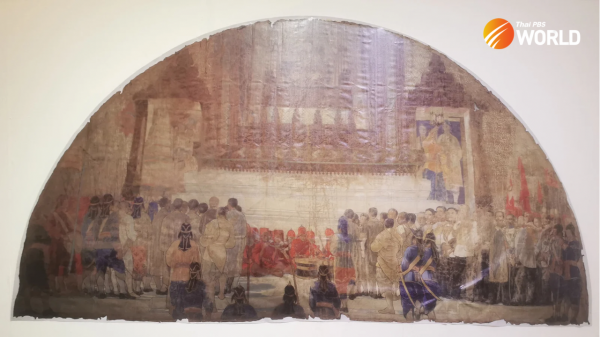
Using science to save art
At the National Gallery, the work of restoring and repairing Chini’s sketch has been conducted by a team of conservation scientists and artists.
Small samples of various areas of the painting by Galileo Chini were removed for scientific examination. These included samples of the canvas, paint, and plaster from various parts and layers of the painting.
Fibre morphology revealed that the canvas incorporated 80% cotton and 20% linen. Galileo Chini, similar to many European painters of his era, applied underpainting on the initial layer before working on the paint layer. The conservators also found calcium sulfate dehydrate and animal protein in the plaster.
“Chini used gypsum and animal binder on his sketch. Adhesive binder analysis in a lab can tell whether it was from hide or bone, mammal or fish,” says Saneh Mahaphol, a conservation scientist who is leading the fresco documentation.
A pigment analysis revealed that Chini only used pure colors. Black paint was created from ashes. White pigment, on other hand, has larger particles than other paints, and it’s prone to deterioration. Red, yellow, brown were synthesized. A microscopic examination also showed the binder had deteriorated over time, leaving hairline cracks all over the outer paints.
“Using an original material is an important aspect for historic art restoration. So the art conservators looked at every single detail in Chini’s sketch before giving it any treatment. We want to use the original materials in the restoration,” Saneh adds.
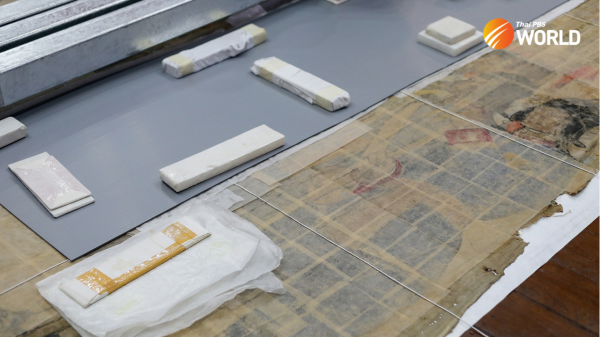
“The binder was corroded over time. If the fresco hasn’t been restored there is a risk that some of the paint might have fallen off,” says Sopit Panyakan, the head art restorer. “Technically, we give the front surface a facing treatment and adhere it with water-based adhesive in order to protect the painting’s surface.”
It’s a long and painstaking process.
Some adhesives may interact with the paint or affect its performance. Art restorers must be aware of how an old painting will react to new binder glue. Making small replicas of the paintings out of similar materials and testing them with new glue is the only way to find out. Even if art restorers find the right glue for the job, they cannot immediately apply it to the painting’s surface.
“The painting has been completely dry for over a century, with no contact with water at all. A painting’s surface will fall off if we press glue, the water-based adhesive, right away,” Sopitadds. “So we give the old painting a wake-up call by applying moisture on it.” Again, for fear of damaging the historic painting, we cannot apply glue directly to its surface. We need to run glue through mulberry paper.”
That century-old sketch, one of Thailand’s largest paintings, is now well preserved, though art conservators cannot say it is complete.
“There is a discussion about retouching colors on Chini’s sketch, but we all agree to put it on hold to preserve its authenticity,” says Sopit.
If you go …
The National Gallery, on Chao Fah Road, is about 10 minutes on foot from Sanam Luang or Khao San Road. It’s open from Wednesday to Sunday (9am-4pm). Galileo Chini’s sketch is not officially on exhibition yet, but visitors can see art restorers working on it on Wednesday-Friday. Call 02 281 2224.
